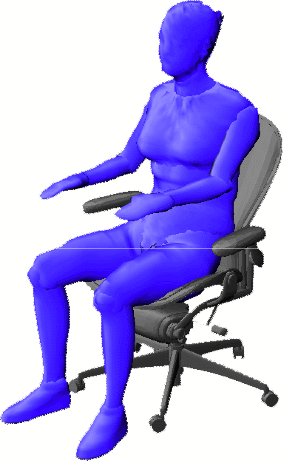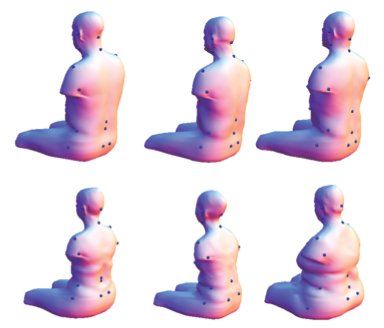>>> Research: Parametric Human Body Models
Parametric Human Body Modeling

A major focus of the Biosciences group at UMTRI is the development of data, models, and techniques to enable the rapid modification of highly detailed finite element models of human anatomy to represent a wide range of human characteristics. Our primary application is morphing whole-body models, such as THUMS and the GHBMC midsize-male, to represent occupants with different body sizes and shapes. However, we are also applying these techniques to modeling heads and other body regions. This research brings together a large range of previous studies and techniques, including vehicle occupant posture measurement and modeling, human body shape modeling, and techniques for extracting and modeling internal human anatomy from CT images.
Modeling Torso Shapes for Chair and Seat Design
The design of chairs and seats has been hampered by a lack of detailed anthropometric data directly relevant to the design problem. Traditional lengths, widths, and circumferences are not very useful for constructing three-dimensional surfaces intended to provide comfortable support for a wide range of the design population.

I've done many body surfaces analyses for Herman MIller, a major office furniture manufacturer. I've developed software to extract the torso data from the scan files and to articulate the torso with smooth surface deformation. Using principal component analysis and multivariate regression, I've created a statistical model that generates torso shapes based on overall anthropometric variables, such as gender, stature, and body weight. Herman Miller uses the tools developed from these analyses to improve their office chair designs.
The figure to the left shows some of the torso models developed by this methdology. Each torso shape is representated by a homologous mesh that can be analyzed to extract desired dimensions (for example surface profiles corresponding to particular anatomical locations) or to calculate distances along the surface. The PCA+regression analysis allows a torso shape to be predicted for any desired combination of body dimensions. For example, various combinations of stature and body mass index (BMI) can be specified for both men and women to obtain boundary cases for use in seat design.

The figure to the right shows the result of exercising the model female torsos. Stature was held constant at a typical median female value while body mass index was varied from 18 to 45. The model shows the average effects of BMI on female body shape. The results can be used to assess the fit and accommodation of chairs, seats, clothing, protective equipment, and other products and facilities designed to be used by a wide range of individuals.
©2024 Matthew P. Reed and The University of Michigan